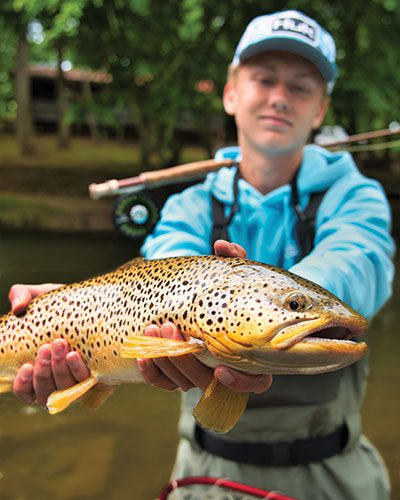Summer has come to an end, and with the cooler temps comes amazing trout fishing. Trout fishing happens year-round in North Georgia, but the fall brings the start of delayed harvest streams and trout spawns. If you’re searching for a big brown or want to venture out of the normal tailrace water, this is the perfect time of year to wet a line.
Trout need water below 70 degrees to survive. During the summer, that required temperature locks you into fishing high mountain streams or dam release tailwaters that are cool, flowing waters. The fall will bring ample more waters that are prime for trout fishing. In fact, the number of good waterways to fish are overwhelming. A great resource to tap into is the Georgia DNR stocking report. As many of the warmer waters start to cool, the GADNR will stock trout for anglers to enjoy. The stocking report is published weekly and released to the public. Do note that the list is for what was stocked the week prior, not the next week where you can be waiting beside a waterway for a trout truck to arrive.
If you’re wanting a chance to hook a trophy fish or if fly fishing is more your style, the start of fall also means the start of Delayed Harvest streams, also abbreviated DH streams. Delayed Harvest streams are single hook, catch and release only with no live bait fishing. Live bait also includes scented baits like power bait or impregnated soft plastics. Be warned that law enforcement watches these areas closely, and I have seen hundreds of anglers receive tickets for breaking the law. In addition to the above regulations, some DH streams have added restrictions like barbless hooks only or fly fishing only.
Knowing where the trout are is half the battle. The other half is knowing how to target them. If you’re up for fly fishing, you’re going to want a 3 to 6 weight, up to a 9-foot rod paired with matching weight fly line and a tapered leader. Some guaranteed, “tried and true” flies for this area are Chubby Chernobyl’s, Wooly Buggers, Rainbow Warriors, Zebra Midges, Blue Winged Olives and assorted Stoneflies.
If you’re more into conventional fishing, you’ll want an ultra-lite, inline spinning setup; a 500-1000 size reel on a 4-to-6-foot rod with 4 to 6-pound line. Daiwa has a phenomenal setup I currently use; the Kage 5’6” UL rod paired with a Kage 1000 LT reel. That setup, or similar, will easily handle any of your jigs, jerks or spinners as well as any trout you hook up to. Some of my favorite conventional lures are inline spinnerbaits from Rooster Tail, Joes Flies, Trout Magnet, or Mepps. I like to use dark colors with gold blades, and I match the weight to the water depth I’m fishing.
Trout are opportunistic feeders that wait in the eddies, seams, deeper holes, or riffles for their food to drift by. You’ll want to cast upstream to them and allow your fly or lure to drift naturally past them. You’ll also want to avoid putting yourself or anchoring too close to where you plan to cast, as they are easily spooked.
Enjoy the break from the heat and get out and wet a line in the cooling temps of the mountains.
William Reed is a Nucanoe National Pro Staff Writer. You can contact him at will@nucanoe.com or find him on InstaGram @wde_will
